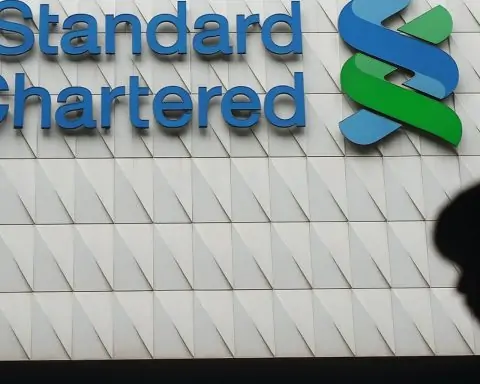Key Facts: JD.com’s U.S.-listed ADRs closed near $33 on Oct 31 [1]. 2025 has seen robust sales growth – Q4’24 revenue jumped 13.4% YoY to RMB347 billion [2], Q1’25 grew 15.8% to RMB301.1 billion [3], and Q2’25 hit RMB356.7 billion (+22.4% YoY) [4]. Margins and profits improved (net income surged in Q4’24 and Q1’25 [5] [6]). Management has returned cash to shareholders, buying back $1.5 billion of stock in Q1 [7]. Analysts are generally bullish – the consensus 12‑month target is about $42 (implying ~25–30% upside) [8] – although some caution that aggressive discounting (in instant delivery, food, etc.) is squeezing profits [9] [10]. Geopolitical winds have shifted: a recent Trump–Xi “trade truce” agreed to roll back some tariffs and pause export curbs on rare earths [11], easing one major overhang for JD and other Chinese exporters. Meanwhile Beijing’s consumer-stimulus measures – from appliance trade‑in subsidies to cut-rate loans – are boosting demand in JD’s core markets [12] [13].
Recent Financial Performance: JD’s latest earnings show steady top-line gains and margin expansion. In Q4’24 (reported Mar 2025), revenue was RMB346.99 billion (+13.4% YoY) [14], driven largely by deep discounting in electronics/home-appliances and government subsidies. Net income jumped nearly 3× YoY (RMB9.9 billion vs RMB3.4 billion) [15], lifting margins. The CEO, Sandy Xu, said she expects “healthier consumption trends this year on a rebound in demand and an AI‑powered improvement in customer experience” [16], reflecting optimism about stimulus measures. Q1’25 (ended Mar 31) saw RMB301.1 billion in revenue (+15.8% YoY) [17] and net income of RMB10.9 billion (+54% YoY) [18]. Operating margins ticked up (non‑GAAP operating profit of RMB11.7 b, 3.9% margin, vs 3.4% year-ago) [19]. CFO Ian Shan noted “solid results on both the top and bottom lines” and strong user growth in Q1 [20]. The company continued its $5 billion buyback, repurchasing ~$1.5 b in Q1 (about 2.8% of shares) [21]. In Q2’25 (reported Aug 14), revenue accelerated to RMB356.7 billion (+22.4% YoY) [22] – the fastest growth in years – with appliances/electronics leading the gain. New businesses are ramping: JD Food Delivery (launched Feb 2025) helped drive “new business” revenues up 199% YoY [23], and core services sales jumped 29.1% [24]. Active customer counts rose over 40% YoY [25]. However, analysts note margin pressure: S&P Global warned that heavy subsidies in instant delivery mean JD’s food-delivery losses “nearly wiped out its Q2 profit,” echoing CEO Xu’s caution that “excessive competition” is unsustainable [26] [27].
Recent News & Corporate Updates: JD has been active on several fronts. In Europe, its bid for Germany’s Ceconomy (owner of MediaMarkt) is moving forward – EU antitrust cleared the deal and Ceconomy now expects FY profit to beat targets [28]. Domestically, JD is extending promotions for Singles’ Day into a multi‑week campaign alongside Alibaba [29], reflecting the industry-wide push to revive weak consumption. New initiatives include an export‑to‑domestic program (buying RMB200 b of export goods for Chinese shoppers) and a $500 m IPO plan for its JingDong Industrials unit [30] [31]. On the regulatory side, JD (like Alibaba) paused plans to issue stablecoins in Hong Kong after Beijing intervened [32].
Analyst and Investor Sentiment: Wall Street sentiment is generally positive. The Benzinga consensus from 16 analysts is a $42.25 price target, high $55 (Barclays) and low $28 (Morgan Stanley) [33]. Most recent reports (from Citi, Benchmark, BofA, UBS) are “Buy” with targets in the high-$30s to $50 range [34] [35]. For example, Citigroup recently reinstated a Buy at a $42 target [36]. Zacks ranks JD a #2 (Buy) after recent upward estimate revisions [37]. Analysts cite JD’s supply‑chain strength and improving user base, but also caution on the margin squeeze from price wars. Kenneth Fong of UBS warned that intense “one‑hour delivery” price wars (in which JD competes with Alibaba/Ele.me, Meituan, Pinduoduo) will likely continue through Singles’ Day and “eat into margins” [38] [39]. S&P Global’s China internet team projects JD (and peers) to burn ~¥160 b in the next 12–18 months on subsidies [40]. On the other hand, CDI (Capital Dynamics) and WPIC (retail consultancy) highlight that JD’s focus on appliances and rising travel/retail data imply underlying demand is slowly improving, especially with government trade‑in subsidies fueling appliance upgrades [41] [42].
Market Performance: JD shares have been choppy but have reacted to broader events. Late Oct, enthusiasm over US-China trade talks lifted JD by roughly 2–3%. On Oct 27, U.S.-listed JD jumped about +2.7–3.0% as investors cheered the prospect of reduced tariffs [43]. More recently (Oct 30–31), the stock slipped about –3% as part of a broader tech pullback; it closed around $33.0 on Oct 31 [44]. (By comparison, Alibaba ADRs have rallied about +58% YTD as of mid‑May [45], highlighting stronger investor confidence in its turnaround.) In premarket trading Nov 3, JD’s ADR is drifting modestly as investors digest the late-breaking trade news [46] and Amazon’s strong results (Amazon jumped ~10% on Oct 30 after blowout AWS growth [47], lifting U.S. tech indexes).
Technically, JD is down from its summer highs (it traded in the mid-$30s after Q2 results) but is well above its 52-week lows (~$26 in early 2025). The stock has found support in the low-$30s; a break below ~$32 on heavy volume would be bearish. Conversely, a sustained move back above the August $35–$36 range (which it briefly touched) would signal resumed momentum. (Charts as of late Oct show JD’s 50-day moving average hovering near the 200-day, implying mixed momentum.)
Macro & Geopolitical Factors: Several macro trends bode well for JD. China’s economy is slowing (Q3 GDP likely ~4.8% YoY [48], below the 5% target), which is pressuring Beijing to lean on stimulus. Authorities have unveiled fresh measures to “boost consumption” – including ¥231 b of electronics/appliance trade-in subsidies [49] and cut-rate loans – directly benefiting retailers like JD. At the same time, the US-China trade war has eased: Presidents Trump and Xi agreed on Nov 1 to roll back certain tariffs (halving some rates) and suspend Chinese export controls on rare-earths [50], averting threatened 100% tariff hikes and extending a one-year “truce.” This development removes a key overhang for Chinese export and tech stocks. On the US side, a likely Fed rate cut in December (investors have priced in 25bps) [51] is buoying risk markets, which may support JD’s ADR trading. The overall backdrop is cautiously positive: stable tech growth globally (e.g. strong cloud demand) and a moderately stimulative China economy should help JD’s retail business. However, risks remain if Chinese consumer spending disappoints or the online price war deepens.
Competition: JD competes head-to-head with Alibaba Group (BABA) and Pinduoduo (PDD) domestically. All three have seen sluggish core growth and are pouring capital into new services. For now, JD’s emphasis on branded appliances and a strong logistics network differentiate it from PDD’s discount-heavy model. (Pinduoduo’s leaner cost structure gave it ~34% operating margins in 2024, versus ~15% for Alibaba and only ~3% for JD [52].) Alibaba, which reported weaker-than-expected Q4’25 revenue in May [53], is nonetheless investing aggressively in instant delivery (Ele.me) and cloud AI. Walmart/Flipkart and Amazon are less direct competitors in China, but Amazon (AMZN) offers a global comparison: it continues to grow revenues strongly (AWS +20% in Q3) and has driven U.S. tech indexes higher [54]. Unlike Amazon, JD’s profit margins and cash burn are tighter due to China’s fierce retail price war [55]. JD’s move into food delivery (JD Daojia) and cross-border imports aims to diversify growth, but these will take time to pay off.
Analyst Outlook: Most sell-side analysts view JD as a “buy” or outperform into 2026, anticipating continued revenue growth around 15–20% annually as consumption recovers. For example, S&P Global expects JD’s overall gross merchandise value to rise in coming quarters even if profits lag [56]. Street forecasts (e.g. Zacks) call for Q3’25 EPS around $0.46 (vs $1.23 in Q3’24) on ~11% sales growth [57]. The consensus long‑term target (mid-$40s) reflects optimism that JD’s scale and subsidies will outlast short-term margin headwinds. That said, analysts note downside catalysts: if China’s economy weakens more than expected, or if competition forces even deeper discounts, JD could fall short. A break below the $30 area could trigger technical selling. On the upside, if consumer stimulus and the trade truce translate into a broad Chinese retail rebound, JD shares could reclaim recent highs.
Bottom Line for Investors: Heading into Nov 3, the consensus tone is cautiously constructive. JD.com has solid fundamentals (growing sales, improving margins, strong logistics) and some tailwinds (US-China detente, Beijing stimulus) [58] [59]. Its key risks are the same that have plagued Chinese e‑commerce: a sluggish recovery in consumer income and an expensive price war for market share [60] [61]. With a P/E below many peers and a ~2.9% dividend yield, JD looks cheaper than U.S. tech peers on paper – but investors should price in volatility. The stock’s immediate direction will likely hinge on global market mood (e.g. tech earnings, U.S. Fed policy) and any new data on Chinese spending. In the near term, analysts highlight JD’s stronger-than-expected user growth and regulatory support as positives, while watching for any earnings warning in Q3. Overall, JD is viewed as a long-term growth story in China’s digital retail, but one that faces headwinds from economic cycles and competitive intensity.
Sources: Company filings and press releases [62] [63]; Reuters news articles [64] [65] [66] [67]; analyst reports and market commentary [68] [69] [70]. All data as of Nov 2, 2025 (pre-market).
References
1. www.benzinga.com, 2. www.reuters.com, 3. www.globenewswire.com, 4. jdcorporateblog.com, 5. www.reuters.com, 6. www.globenewswire.com, 7. www.globenewswire.com, 8. www.benzinga.com, 9. www.reuters.com, 10. www.reuters.com, 11. www.reuters.com, 12. www.reuters.com, 13. www.reuters.com, 14. www.reuters.com, 15. www.reuters.com, 16. www.reuters.com, 17. www.globenewswire.com, 18. www.globenewswire.com, 19. www.globenewswire.com, 20. www.globenewswire.com, 21. www.globenewswire.com, 22. jdcorporateblog.com, 23. jdcorporateblog.com, 24. jdcorporateblog.com, 25. jdcorporateblog.com, 26. www.reuters.com, 27. www.reuters.com, 28. www.reuters.com, 29. www.reuters.com, 30. jdcorporateblog.com, 31. www.reuters.com, 32. www.reuters.com, 33. www.benzinga.com, 34. www.benzinga.com, 35. www.benzinga.com, 36. www.benzinga.com, 37. www.nasdaq.com, 38. www.reuters.com, 39. www.reuters.com, 40. www.reuters.com, 41. www.reuters.com, 42. www.reuters.com, 43. www.reuters.com, 44. www.benzinga.com, 45. www.reuters.com, 46. www.reuters.com, 47. www.fxempire.com, 48. www.reuters.com, 49. www.reuters.com, 50. www.reuters.com, 51. www.reuters.com, 52. www.reuters.com, 53. www.reuters.com, 54. www.fxempire.com, 55. www.reuters.com, 56. www.reuters.com, 57. www.nasdaq.com, 58. www.reuters.com, 59. www.reuters.com, 60. www.reuters.com, 61. www.reuters.com, 62. www.globenewswire.com, 63. jdcorporateblog.com, 64. www.reuters.com, 65. www.reuters.com, 66. www.reuters.com, 67. www.reuters.com, 68. www.benzinga.com, 69. www.reuters.com, 70. www.reuters.com







